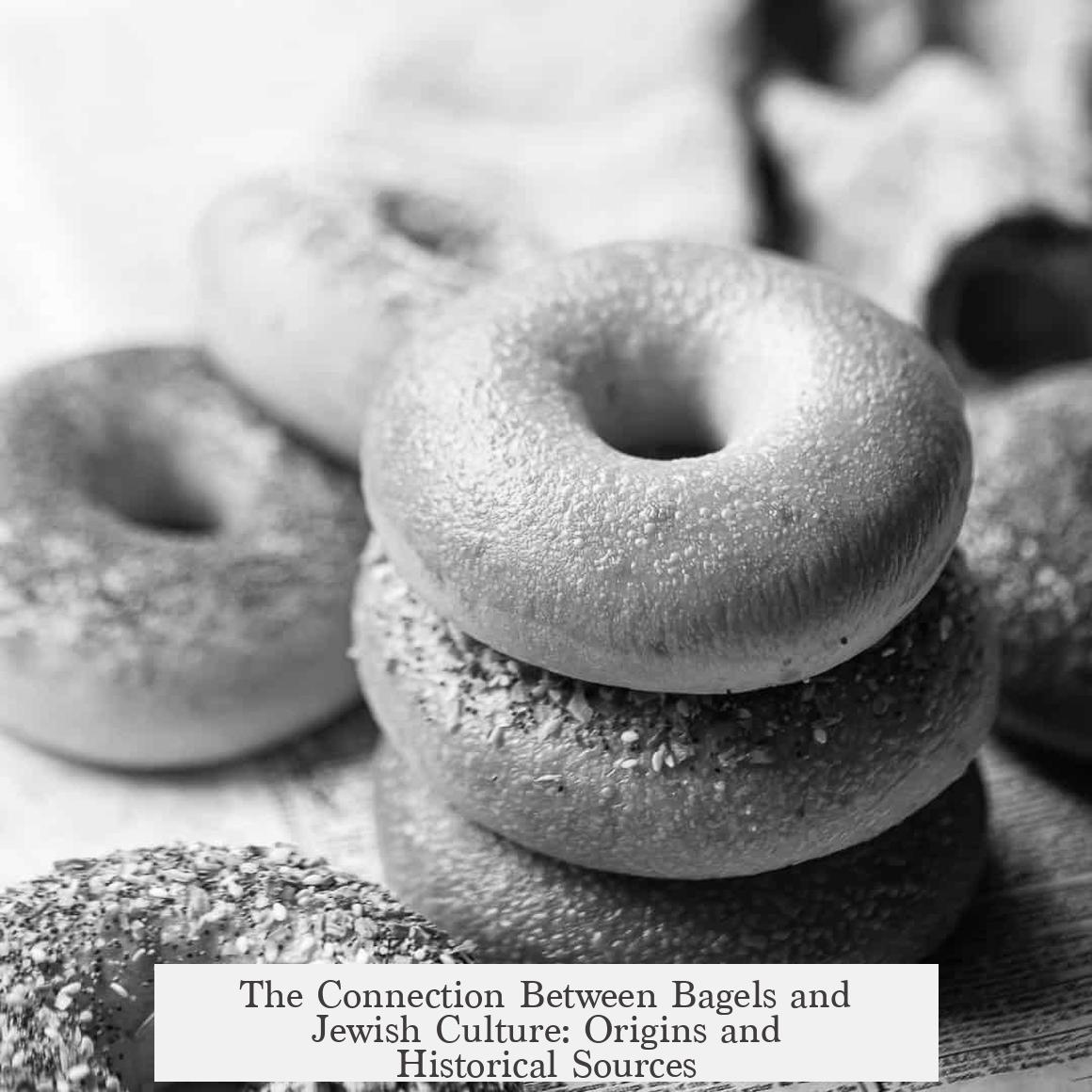Bagels become associated with Jewish culture primarily through adoption by Jewish communities in Poland, followed by immigration to the United States, rather than from any original invention tied directly to Jewish traditions. The term “bagel” derives from the Yiddish word beygal, which in turn comes from the German Beugel. This bread form likely arrived in Poland with German immigrants in the 13th century. It mirrors the shape and style of the Krakowski Obwarzanek, a traditional Polish bread ring.

The bagel’s connection to Jewish culture grew in Poland during the late medieval period. Evidence appears from the early 1600s within Jewish legal texts, notably sumptuary laws authored by rabbis. These laws prescribed what foods could be consumed by different social groups, referencing bagels (or their predecessors) explicitly. This demonstrates an established presence of bagels within Jewish dietary practices.
Polish bakers’ guild regulations of 1496 restricted certain bread production rights; however, Jews were not formally barred from baking. Many abstained from baking due to religious prohibitions against handling key ingredients like butter and lard. This abstention, rather than exclusion, shaped the Jewish culinary patterns involving bagels in Poland.

Bagels arrived in the United States in the early 20th century via Polish Jewish immigrants. New York City’s large Jewish population created demand for kosher-style foods, and bagels became a staple. The Lender family’s automation of bagel production in the 1960s helped popularize bagels across North America, reinforcing their association with Jewish culture and kosher dietary laws.
Regarding primary sources, historian Maria Balinska’s 2009 book A History of the Bagel remains the key reference. Balinska notes no direct mentions of bagels before 1610 and dismisses the popular legend that bagels originated as a symbol of Jewish resistance against Christian oppression. This connection is a modern myth without documentary evidence. Early references are strictly culinary or regulatory rather than symbolic or politically motivated.

| Topic | Details |
|---|---|
| Origin | Derived from German Beugel; brought to Poland by German immigrants in 13th century |
| Jewish Association | Referenced in Jewish sumptuary laws from 1610 onwards; no invention claim |
| Polish Baking Context | Guild rules in 1496; Jewish bakers mostly abstained due to religious constraints |
| U.S. Popularity | 1900s Polish Jewish immigrants brought bagels to NYC; 1960s automation popularized bagels |
| Primary Sources | Maria Balinska’s 2009 book; early Jewish legal texts; no evidence linking bagels to oppression symbolism |
- Bagels originate from European Christian bread traditions, not as a Jewish invention.
- Jewish cultural association developed through adoption and immigration.
- Historical Jewish texts mention bagels from early 17th century.
- No verified primary sources link bagels to Jewish political or religious resistance.
- Popular myths about bagels as symbols of oppression lack documentary support.
When and How Did Bagels Become Associated with Jewish Culture?
Bagels became associated with Jewish culture primarily after their arrival in Poland from German immigrants in the 13th century, when Jewish communities adopted and adapted the bread, and later, Polish Jewish immigrants popularized the bagel in the United States in the early 1900s. This connection deepened over centuries through cultural integration and dietary customs, as evidenced by early Jewish texts and sumptuary laws from the 17th century onward.

Let’s explore this fascinating journey from a humble German ring-shaped bread to an iconic symbol of Jewish culinary tradition, while distinguishing fact from popular myths.
The Origins: From Beugel to Beygal

The bagel we know today traces its lineage to a German bread called Beugel, which literally means “ring” or “bracelet.” This connection helps explain the bagel’s classic circular shape with a hole in the middle. The Yiddish word beygal, from which “bagel” descends, roots firmly in this German term.
Interestingly, bagels did not start as an exclusively Jewish bread. German immigrants brought Beugel to Poland during the 13th century. In Poland, this bread evolved alongside local varieties like the Krakowski Obwarzanek, a similar ring-shaped bread from Krakow.

“Bagel comes from the Yiddish word beygal, which is derived from Beugel. They were thought to have been brought to Poland by German immigrants, who emigrated in the 13th century. They came to resemble a similar bread common in present day Krakow, Poland, Krakowski Obwarzanek.”
The bagel’s shape also has early Christian associations. It was traditionally baked during Lent, a period of fasting when Christians abstained from certain rich foods.

Medieval Poland and The Bakers Guild
By the late 14th century, the bagel-like bread had found favor among Polish elites. Polish Queen Jadwiga (or Hedwig) apparently enjoyed bagels as a Lenten snack around 1396.
However, the baking of white breads, including bagel-type breads, was regulated by the Polish Bakers Guild, which controlled who could bake these breads and when. The guild was exclusive but did not explicitly forbid Jewish bakers.
Despite this, most Jews did not bake bagels or other similar breads in Poland during this era. Why? Because the two main fats used in baking at the time were butter and lard, both prohibited by Jewish dietary laws.
“In 1496 the Bakers Guild in Poland, was given exclusive access to bake white breads. The bagel type bread continued to be made only during Lent, and only by a specially designated members of the bread baking guild… Jews were not explicitly prevented from being bakers. While they may have indeed faced discrimination of some kind, They largely abstained from baking careers, due to their sincerely held religious beliefs that prevented them from working with the two main ingredients of baking at the time: butter and lard.”
This abstinence reveals that the early Jewish association with bagels was complex and indirect, not an outright invention or exclusive claim.
Bagels’ Journey to America and The Jewish Connection
The association between bagels and Jewish culture becomes clearer when the story crosses the Atlantic. Polish Jewish immigrants brought their culinary traditions, including bagel baking, to New York City during the early 20th century.
The dense Jewish population in New York created a vibrant market for kosher foods, including bagels. It was there that bagels transitioned from a niche ethnic food to a staple within American Jewish communities.
Later, in the 1960s, the Lender family industrialized bagel production, making them available beyond Jewish communities and contributing to the bagel’s North American popularity. Despite this mass production, the bagel maintained its reputation as a kosher and Jewish-associated food item.
“As to how they became known in the United States: Polish immigrants brought the concept of bagel making to NYC in the early 1900s. Due to the large population of Jews in the city, there was a large demand for kosher foods like bagels. The bagel came into more general use throughout North America in the last quarter of the 20th century with automation, namely on behalf of the Lender family, who made bagels popular in the Northeast United States in the 1960s… They continued to be associated as a Kosher food.”
Early Primary Sources: What Did Jewish and Non-Jewish Writers Say?
The earliest textual mention of the bagel dates back to 1610, where references appear in Jewish texts noting their consumption and inclusion in sumptuary laws. These laws, issued by rabbis, outlined appropriate food consumption practices for various households. The bagel’s mention in these contexts shows its established place in Jewish life by the early 17th century.
Maria Balinska, a modern scholar known for her thorough research on bagel history, clarifies many misconceptions. Her 2009 book A History of Bagels remains the authoritative source.
Balinska debunks the popular myth that bagels were invented by Jews as a staple to circumvent Christian oppression, finding no credible evidence that this oral tradition has any historical basis.
“The primary citation for most modern sources on the history of Bagels comes from the 2009 book, A History of Bagels by Maria Balinska. According to this book, ‘There is no direct mention of Bagels before 1610.’ The bagel appeared in a number of Jewish ‘sumptuary laws,’ written by rabbis to mandate just what kinds of foods … could be enjoyed by specific households and individuals.”
“According to Balinska, the explanation of bagels rooted in Christian oppression, is a ‘folk tale.’ However, Balinska wrote at length about various alleged acts of oppression against Jews perpetrated by Christians, that have nothing to do with the history of Bagels, nor are any citations provided for these events.”
“While bagels are largely associated with being a Jewish food in modern times, and credit can be given to the Jewish community for their popularity in the United States, they were not invented by Jews for the purpose of circumventing Christian oppression.”
Summing Up: What We Now Know
- Bagels have their roots in European Christian bread traditions, particularly the German Beugel.
- Their arrival in Poland by German immigrants allowed Jewish communities to adopt this bread, giving it a special cultural significance over time.
- Historical Jewish texts from the early 1600s reference bagels, showing they were part of Jewish life by then.
- Jewish dietary restrictions influenced baking practices, initially limiting direct Jewish involvement in bagel baking in medieval Poland.
- The strong association between bagels and Jewish culture largely results from Polish Jewish immigrants who popularized the bagel in the U.S.
- The common legend that bagels were invented by Jews to resist Christian oppression is unsupported by any reliable primary source.
So, next time you enjoy a crisp, chewy bagel, remember you’re savoring a food with deep, multicultural roots. It’s a testament to centuries of migration, adaptation, and cultural exchange — not just a tasty snack with folklore attached.
Isn’t it fascinating how a simple bread ring can weave together stories of faith, migration, and commerce across centuries? And maybe, just maybe, knowing the real history makes that sesame seed on your bagel taste a little richer.
References
- European Union official page on Polish bagel bread
- Balinska, Maria. A History of Bagels. Princeton University Press, 2009.




